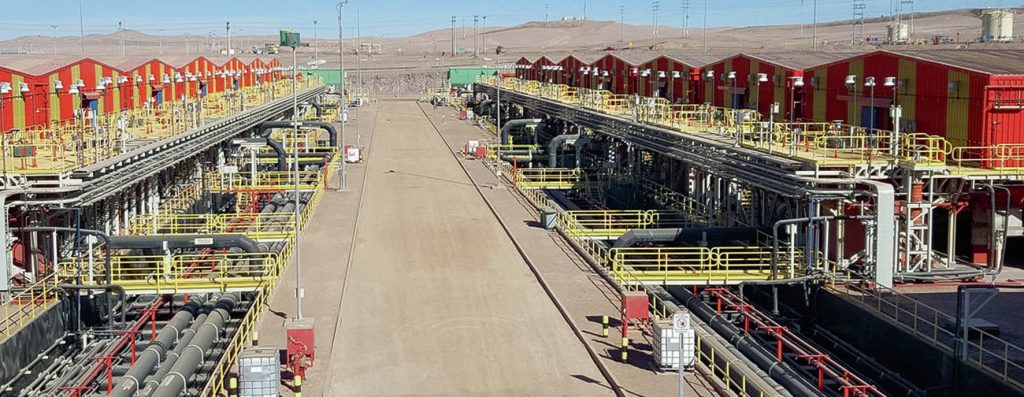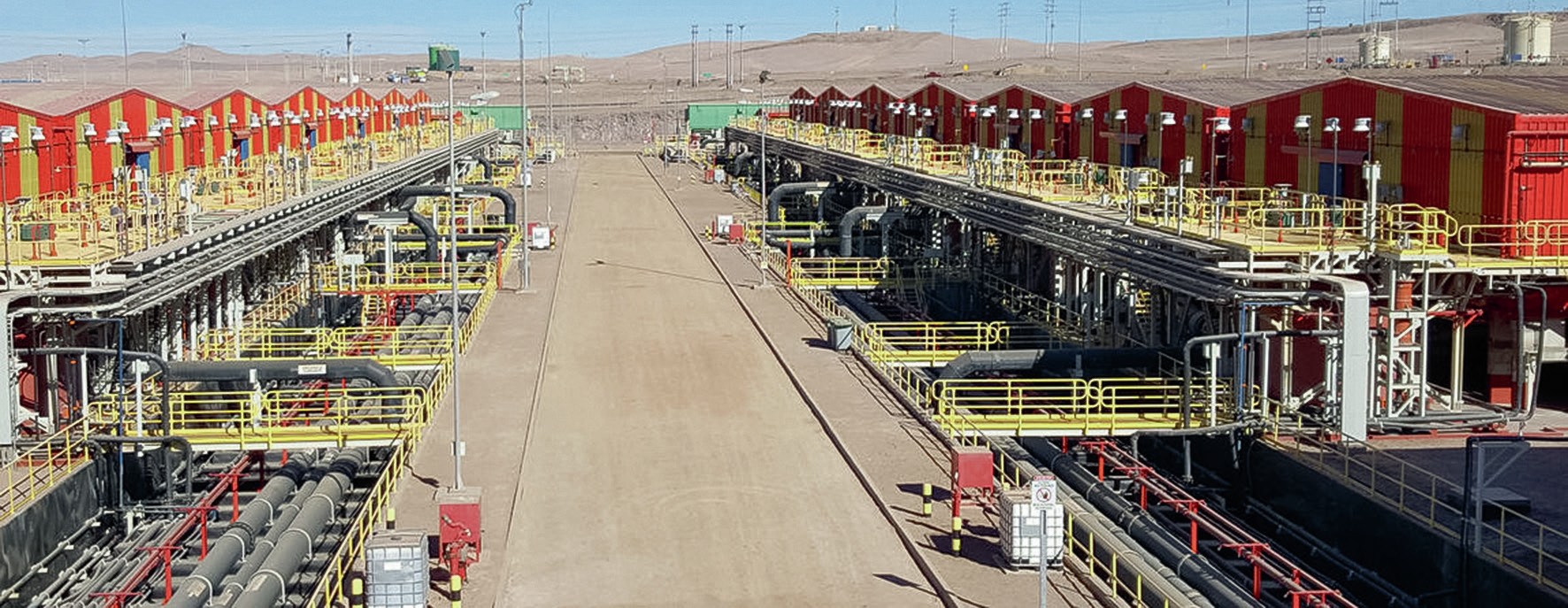Sulphur 389 Jul-Aug 2020

31 July 2020
Sulphuric acid leaching
LEACHING
Sulphuric acid leaching
There was a rapid increase in sulphuric acid demand for copper, uranium and nickel leaching from 1995-2015, but over the past few years growth in this sector has slowed dramatically. Now however there are signs that demand is starting to pick up again with several new projects under development.

Metal oxide ores are often treated with sulphuric acid to recover the metal as a soluble sulphate. This leaching process is a major consumer of sulphuric acid, accounting for just over 10% of all acid demand in 2018, and consuming over 27 million t/a of acid. While precious metals and rare earths processing accounts for a small proportion of this, the three key demand sectors are copper, nickel and uranium.
Copper
Copper’s use of sulphuric acid for leaching consumes around 15 million t/a of sulphuric acid. This figure grew rapidly in the early years of the 21st century, particularly in Chile, Peru and the USA. Hydrometallurgical recovery using solvent extraction/electrowinning (SX/EW) became a favoured technique because it can access lower grade ores in an economic manner, it is a relatively easy and simple technique, and avoids the high capital costs of smelting. However, it also generates acidic waste which must be treated, and it is often easier to idle in periods of low metal prices, something which became apparent when copper went through a period of low prices in 2015-2017, and a number of SX/EW plants were shut down.
There are few large copper mines now that run purely on SX/EW, and most are part of a combination with conventional concentrates production, with SX/EW often being used on lower grade mine tailings. Production from the largest SX/EW producer, Chile, is set to fall over this decade, as old mines become exhausted. This year Cochilco, the Chilean Copper Commission, forecasts that the country will recover 1.54 million t/a of copper via SX/EW. But by 2025 this is expected to fall to 1.34 million t/a, and by 2030 Chile will produce only 0.75 million t/a of copper by SX/EW; less than half its current value. In terms of overall copper output, this will be more than compensated for in Chile by a rise in copper concentrates production, but for sulphuric acid it will mark a decisive change in Chile’s acid consumption, and possibly an end to Chile as a major importer of merchant acid. Whether it will also drive Chile to build more domestic smelter capacity remains to be seen.
Set against this fall, there is a new wave of SX/EW projects, together with re-starts of previously shuttered projects which are driving new consumption in places such as Mexico, Indonesia and the Democratic Republic of Congo and Zambia in southern Africa’s ‘copper belt’. In the United States, Freeport-McMoRan is starting up its new Lone Star mine in Arizona which will aim to produce 100,000 t/a of copper in its initial phase via SX/EW, with the potential for further expansion. However, overall, the International Copper Study Group forecasts that these will only just about balance reductions in SX/EW production from Chile out to 2023, with a slight overall uptick towards the end of that period to a total of 5.2 million t/a of copper from the current approximately 4.8 million t/a.
Nickel
Nickel oxide ores are not the most favoured for nickel production because they tend to be lower grade and more difficult to extract. However, in the 1990s a lack of available sulphide ore bodies led to a move towards nickel leaching via the aggressive high pressure acid leach (HPAL) process. In the 2000s, nickel demand for sulphuric acid leaching was mainly provided by the long standing Moa Bay HPAL plant on Cuba, together with four new projects in Australia (see our article elsewhere in this issue) at Cawse, Murrin Murrin, Bulong and Ravensthorpe. Technical difficulties and high operating costs led to two of these shutting down that decade, but at the same time other HPAL projects, in the Philippines, Papua New Guinea, New Caledonia and Madagascar were also under development, and all began ramping up production during the period 2010-2015. As a consequence, sulphuric acid demand for nickel processing rose rapidly during this period, almost tripling in five years to reach around 8 million t/a, most of it provided by dedicated sulphur-burning acid plants near the HPAL unit (although the first Philippine project, operating by Sumitomo, uses surplus acid from Sumitomo’s smelters in Japan).
By the late 2010s, however, Chinese demand for nickel, mostly for stainless steel, began to move towards use of so-called nickel pig iron (NPI), an iron-nickel amalgam which can be produced relatively simply from lower grade iron-bearing nickel ores. This surge in NPI depressed nickel prices, and meant that most of the HPAL plants ended up operating at a loss. This led to the closure of Ravensthorpe in 2017, although it has since reopened this year. Two factors have turned this situation around. The first is Indonesia’s ban on exports of low grade nickel ores, meaning that Chinese NPI producers have had to set up ferronickel operations in Indonesia instead, temporarily decreasing nickel supply and increasing costs. The second has been the need for pure grades (‘Class 1’) nickel for battery production, with an anticipated surge in electric vehicle (EV) production responsible. As HPAL is the leading process for producing Class 1 nickel from low grade laterite ores, there has been a huge increase in interest in the process and many new projects looking for funding.
Nickel demand for battery uses is growing rapidly. This year it is expected to be around 120,000 t/a, or about 5% of the nickel market, but by 2025 demand is forecast to be over 530,000 t/a, which will represent more than 20% of the nickel market at that time. Many countries are phasing out production of internal combustion engine vehicles from 2030 or 2040, and some earlier than that. CRU estimates that 2/3 of all new nickel demand out to 2040 will come from the EV battery sector.
Nickel prices have risen from a low of $9,500/tonne in 2017 to an average of $12-13,000/t (and peaks of $16,000/t), and a growing shortage of Class 1 nickel is forecast out to 2025, sufficient to justify investment in new HPAL capacity.
At the moment much of the interest in new HPAL production is in Indonesia, the world’s largest nickel miner – there is a ready source of ore from existing mines, and the government is keen to encourage downstream processing to capture more value from them. There is heavy Chinese investment in these plants, as China is looking to massively increase EV use this decade. New projects under development currently include:
- PT Halmahera Persada Lygen, a joint venture between Harita Group and Ningbo Lygend at Obi Island) – 37,000 t/a of nickel capacity due on-stream in late 2020.
- Tsingshan, GEM and CATL at Morowali on Sulawesi – 50,000 t/a of nickel capacity, due for start-up in late 2021.
- The PT Huayue Nickel Cobalt joint venture between Zhejiang Huayou, Qingchuang, Woyuan, and IMIP, again at Morowali on Sulawesi – 60,000 t/a of nickel capacity, also claiming a 2021 timeframe for start-up.
- Sumitomo and PT Vale Indonesia at Pomalaa on Sulawesi – 40,000 t/a of nickel capacity scheduled for about 2025.
Outside of these projects, there are also considerable interest in Australia, which actually has the world’s largest nickel laterite reserves. As discussed in our article this issue, these include the 20,000 t/a Clean TeQ HPAL project in New South Wales, a 12,000 t/a HPAL project for Australian Mines in Scandi, Queensland, and the 9,300 t/a Ardea Resources project at Goongarrie in Western Australia.
These projects are all currently seeking funding, but more certain are two other HPAL projects – an expansion at the Metallurgical Corporation of China (MCC) Ramu nickel mine on Papua New Guinea, which will add 35,000 t/a of capacity. Ramu is one of the few HPAL plants that has performed according to schedule. In Brazil, there is also an 18,000 t/a HPAL project (in Phase 1) being developed by Horizonte at Vermelho. Horizonte is targeting startup in 2025 for Vermelho, along with a large scale ferronickel project nearby at Araguaia.
The raw material for batteries is actually nickel sulphate, and so as well as HPAL, companies are looking at other ways of producing nickel sulphate, either from recycling existing batteries or processing industrial waste streams, and this again occasionally requires sulphuric acid. In Australia, BHP is planning to produce nickel sulphate at its Nickel West site at Kwinana by acidifying nickel dust using sulphuric acid.
Uranium
Uranium recovery usually requires a leach step, often by pumping a leaching agent into the ore body itself (in situ leaching or ISL). Various leach agents are used, according to the rock type, including hydrogen peroxide or alkali hydroxides, but the most common is sulphuric acid. This has been used particularly in Kazakhstan, where the limestone-heavy rocks consume large quantities of sulphuric acid in the leach, using sulphur bought from the various sour oil and gas projects around the Caspian Sea. Current global demand for uranium is about 67,000 tU/a according to the World Nuclear Association. About 46% comes from conventional mine, 50% from in situ leach, and 4% is recovered as a by-product from other mineral extraction (copper or phosphates). Uranium leaching consumes around 4 million t/a of sulphuric acid, with Kazakhstan accounting for about 60% of that. Global uranium consumption was hit heavily by the Fukishima nuclear accident in Japan, which led Japan, a major nuclear power producer, to essentially close down its entire nuclear industry and switch to gas. However, countries such as France and the US have now delayed plans to phase out nuclear generation capacity, and the World Nuclear Association now forecasts a 15% increase in nuclear energy generation this decade, with most of the new capacity additions in China and India, leading to a modest increase in sulphuric acid consumption.
Nickel the star again?
With only modest increases forecast from new uranium and copper leaching, it is clear that any significant growth in acid consumption from this sector is likely to come from nickel HPAL plants. A note of caution must therefore be sounded, as these projects are expensive and technically challenging and temperamental, and historically have often taken several years to reach even 80% of nameplate capacity. The nickel market has been very volatile, with new techniques and political decisions like Indonesia’s ore export ban driving prices up and down. However, the need for batteries for electric vehicles is a compelling commercial justification at the moment. In the period 2010-2015, acid consumption for HPAL nickel plants rose by more than 5 million t/a, and the rush of new HPAL capacity could see this repeated or even exceeded this decade. Most of these plants will include dedicated sulphur burning acid plants, and sulphur consumption in southeast Asia and Australasia will therefore rise accordingly.






